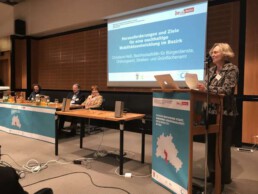"Growing City, Sinking Quality of Life?" Symposium
New mobility: getting Tempelhof-Schöneberg ready for the future
Berlin’s population is expected to reach 4 million people by 2030, bringing 130,000 additional vehicles onto its roads. Already today, the city is close to a traffic infarct and different innovative public space concepts compete against each other. Christiane Heiß, district councillor for citizen services, the public order office, the regional office of public roads and green space, and the project New Mobility Berlin collaborate to limit conflict and concern through innovative concepts of mobility.
On February 15, 2018, under the motto “Growing city – sinking quality of life?” about 100 mobility experts discussed inside the town hall of Schöneberg about:
- What problems exist in the district regarding space requirements of motorized private transport
- Ideas and solutions regarding how mobility services can improve quality of life in Berlin
- Which initiatives in Tempelfhof-Schöneberg take action to make public space safer and better for all road users?
"The mobility turnaround in Berlin is in full swing – I support this because mobility as a service creates many advantages for the city and its inhabitants!"
- Christiane Heiß, district councillor for traffic in Tempelhof-Schöneberg
"Primarily to relieve the inner-city streets from unnecessary traffic, we strongly rely on parking space management."
— Hartmut Reupke, Senate Department for the Environment, Transport and Climate Protection
Energetic at all levels
To set the course for a car-reduced future, participants demanded a state-district cooperation in relation to mobility and liveable neighbourhoods. Whether cycling highways, improved public transport or broadened parking space management, what is needed are constructive concepts which are perceived by the majority of people as feasible and worthy of support.
Also a sustainable improvement of the framework for mobility as a service (MaaS) was on the agenda. That more Berliners get rid of their private vehicles and instead use the public transport, carsharing, scooter-sharing or (cargo) bike-sharing, was a request of the participants. The freed up space in the neighbourhood could thus be rethought and redesigned by citizens and administration.
"The goal of the project NEUE MOBILITY BERLIN is to reduce the space requirement of stationary traffic and thus to increase the quality of life in the city!"
- Dr. Gabriele Wendorf, Center for Technology and Society (TU Berlin)
Plausible parking space management
Parking space management, which has been successfully implemented in parts of the city, were brought up often during the discussion. In the opinion of the assembly, it brought more freedom for future planning. Bigger negotiable areas in public space would allow to scale up e-mobility concepts and its associated and necessary charging infrastructure. Thanks to an efficient use of the carpark offering, the traffic in search for a parking space, as well as parking violations such as second lane parking could be reduced. Residents, businesses and trade benefit from better accessibility of free parking spots.
Need-oriented city
It was also noted that convenient consumer offers such as e-bikes and pedelecs, mobility apps and delivery services dynamically change the daily life of the urban population. Hence, personal dependence on privately owned cars decreases. How public space can and must adapt to these as well as future usage scenarios should be negotiated in close cooperation between all stakeholders in Tempelhof-Schöneberg.
"It is essential to keep in mind what exactly urban society requires."
- Hartmut Reupke, Senate Department for the Environment, Transport and Climate Protection
